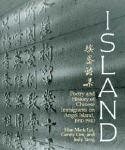Description from the Intoduction Publisher's Information on the Book ORDER -- Item #1264, Price $19.95 Book Description from the Back Cover Written by the New York Times"For thirty years, from 1910 to 1940, Angel Island in San Francisco Bay was the first, often the only, toehold in America for immigrants from China. From the Cantonese Pearl River delta district of Taishan they sailed, fleeing famine and the foreign concessions, bound for the land of the Flowery Flag, the Gold Mountain. Some were relatives of earlier Chinese immigrants who had come to America for Sutter's gold and stayed to help lay transcontinental railroad tracks. Others, in their anxiety to get to America at whatever cost, pretended to relatives and arrived with identification papers bought in Canton and, with 'coaching papers,' carefully constructed and memorized family backgrounds that they hoped would pass them through immigration examiners. The Chinese Exclusion Act of 1882 had been relaxed somewhat under pressure from Chinese Government officials in Canton by 1910, when Angel Island was opened, for Chinese immigrants only. But the immigration laws, so far as the Chinese were concerned, seemed designed to exclude rather than to admit...."During the time they spent on the island, as little as a few days, as long as three years, they carved and inkbrushed their concerns onto the walls of their barracks. One hundred thirty-five calligraphic poems survived, first discovered by a Federal park ranger after Angel Island, was abandoned in 1940. These tell of voyages from China, detainment on the island, attitudes toward the first Americans encountered - immigration officials and social workers - and finally the disappointments and triumphs of the immigrants.
"To augment the translations of the poems the authors have interviewed older Chinese who once passed through Angel Island and immigration workers as well, and have set their recollections down verbatim as oral history. Together with the interviews, the poems - angry, heroic, wrenchingly forlorn, despairing, provocative, resistant - convey, as no secondhand or thirdhand account could ever do, what it was like to be Chinese and to be on Angel Island." Description from the IntoductionAngel Island, now an idyllic state park out in San Francisco Bay not far from Alcatraz, was the point of entry for the majority of the approximately 175,000 Chinese immigrants who came to America between 1910 and 1940. Modeled after New York's Ellis Island, the site was used as the immigration detention headquarters for Chinese awaiting jurisdiction on the outcomes of medical examinations and immigration papers. It was also the holding ground for deportees awaiting transportation back to the motherland. The ordeal of immigration and detention left an indelible mark in the minds of many Chinese, a number of whom wrote poetry on the barrack walls, recording the impressions of their voyage to America, their longing for families back home, and their outrage and humiliation at the treatment America accorded them.When the center's doors shut in 1940, one of the most bitter chapters in the history of Chinese immigration to America came to a close. The poems expressing the thoughts of the Chinese immigrant were locked behind those doors and soon forgotten. Those poems have been resurrected and preserved in this book.
About | Contact | New | Specials | Browsing | Ordering | Conference | Links | Help Copyright © 2007 by AACP, Inc. Most recent revision January 10, 2007 |

